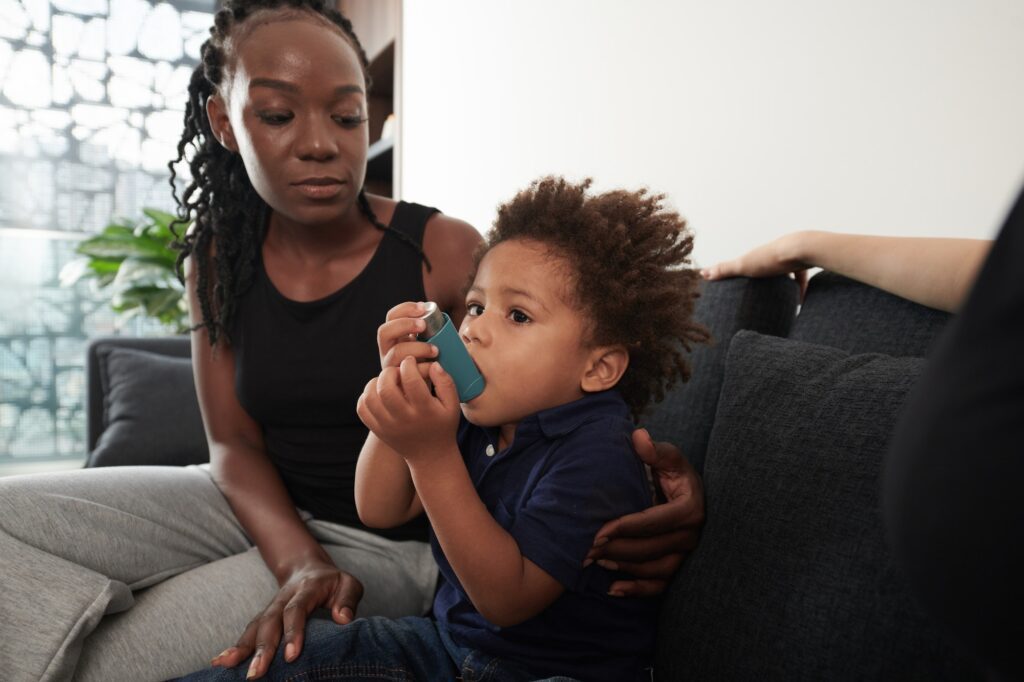In the United States, Black and Hispanic children have more asthma and asthma-related symptoms than White children.
Childhood asthma remains the leading chronic disease of childhood in the US, and the annual incidence is increasing, most rapidly among children younger than 5 years.
What is asthma, or childhood asthma?
Asthma is a chronic (long-term) condition that affects the airways in the lungs. The airways are tubes that carry air in and out of your lungs. If you have asthma, your airways can sometimes become inflamed and narrowed. This makes it harder for air to flow out of your airways when you breathe out.
Studies are revealing that asthma is increasingly more prevalent in children. Childhood asthma has become a global concern because it occurs during the final stages of the formation of the respiratory system.
Asthma is a chronic condition that affects 1 in 13 Americans.

According to the Centers for Disease Control and Prevention, about 1 in 13 people in the United States has asthma. It affects people of all ages and often starts during childhood. Certain things can worsen asthma, such as pollen, exercise, viral infections, or cold air. These are called asthma triggers. When symptoms get worse, it is called an asthma attack.
There is no cure for asthma, but treatment and an asthma action plan can help you manage it. The plan may include monitoring, avoiding triggers, and using medicines.
Who is prone to childhood asthma and why?
Genetic factors, outdoor air pollution caused by PM2.5, PM10, SO2, NO2, environmental tobacco smoke, and coal, indoor pollution, and inhaled allergens, such as house dust mites, pollen, and cockroach particles, are all risk factors for asthma (3). Further, increasing evidence suggests that environmental and genetic factors affect airway development and function in early life (4).
Track environmental pollution like PM2.5, PM10, SO2, NO2, Ozone, pollen, and more using the Best Life Health Diary built by the Live Learn Innovate Foundation. Download it free on app stores.
Results from multiple studies add to the mounting evidence for a heritable component of asthma. This should provide further incentive for asthma providers to thoroughly question their patients about family history, as it is a risk factor for asthma mortality (5).
Inspired by the national study “Childhood Asthma Incidence, Early and Persistent Wheeze, and Neighborhood Socioeconomic Factors in the ECHO/CREW Consortium” which was published here: https://jamanetwork.com/journals/jamapediatrics/article-abstract/2792664
Key points
Question
Is there an association between neighborhood characteristics at birth, race, and ethnicity and the risk of developing childhood wheeze and asthma?
Findings
In this cohort study, we used survival analysis to find that children born in census tracts with higher population density and a greater proportion of low-income households and poverty had higher hazard ratios of asthma incidence after adjusting for individual-level characteristics. Black and Hispanic children were at significantly higher risk for developing asthma than White children. When we examined the risk for asthma across neighborhoods of all income levels, these children remained at increased risk for childhood asthma.
Meaning
Neighborhood characteristics at birth, race, and ethnicity play a role in the development of childhood wheezing and asthma; strategies to reduce asthma disparities must consider the multilevel factors that underlie these findings, including structural and social determinants of health.
In conclusion…
When researchers controlled for individual differences, children born in areas with higher population density and a greater proportion of low-income households and poverty had higher occurrences of childhood asthma cases and symptoms.
Source one. Source two. Source three. Source four. Source five.
Who we are
The Live Learn Innovate Foundation is a 501(c)3 nonprofit entity that empowers software users to regain control of their personally generated health data, gain intuitive insights about their social data, learn the impact of their environment on health, and build a foundation of data analytics that empowers research, academics, and innovation in economic development.
Use cases for this secure, private data aggregation method appear everywhere, expanding to family care, community growth, agricultural planning, and many more things still unseen. Help us keep going by getting involved today.